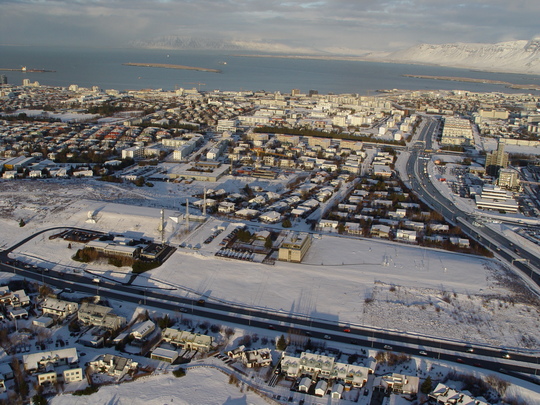The weather in Iceland 2006
A report from the Icelandic Meteorological Office 4 Jan 2007
A general overview
The year was generally favourable and warm. In the South and West the temperature was about 1.1°C above the 1961-1990 normal and 1.3 to 1.8°C above normal in the North and East. The average temperature in Reykjavík was 5.4°C. It ranks as the eleventh warmest year in Reykjavík since the inception of continuous measurements there, in 1870. At Akureyri in the North the average temperature was 4.6°C, also being the eleventh warmest in the record. In Stykkisholmur in the West it was the thirteenth warmest (registration started in 1845), and the fifth warmest at Teigarhorn in Eastern Iceland (measurements started in 1873). The 10-year period completed with 2006 is the warmest in Reykjavík during the whole measurement period, but the difference between 1997 to 2006 on one hand and 1932 to 1941 on the other is not significant. At Akureyri the earlier period is slightly warmer than the present one.
The precipitation total in Reykjavík in 2006 was 890 mm, 11% higher than the 1961-1990 normal, 549 mm were measured at Akureyri, 12% above the normal. The year was sunny in Reykjavík, bright sunshine was registered 1494 hrs, 226 above the 1961-1990 normal, the excess was mainly present during the spring. In Akureyri the bright sunshine hours were 1034, slightly below the 1961-1990 normal.

The highest temperature of the year in the country was measured at Ásbyrgi in the Northeast on 3 August, 25.7°C, and the lowest at Brúarjökull in the glacial inland on 18 November -26.1°C, the lowest temperature at an inhabited station occurred on the same day at Möðrudalur in the north-eastern inland, -25.3°C. The absolute maximum temperature of the year in Reykjavík was 19.2°C, on 1 August and the lowest 18 November, -13.5°C.
The largest 24 hr rainfall was measured at Kvísker in the Southeast on 20 December, 175.3 mm.
The seasons and the individual months
The winter (December 2005 to March 2006) was very warm, in Reykjavík and Akureyri it was the fourth warmest since the inception of continuous measurements. Overall the snowfall was very light, especially in the usually snowy areas of the North and East. In Reykjavík (the Southwest) the days of full snow cover were only 36 during the winter, 19 fewer than the average. This was the sixth consecutive winter with below average snow cover in Reykjavík.
January was quite variable; the weather was generally warm with heavy precipitation in the South and West, but relatively dry in the Northeast. February was also warm, the fourth warmest since the inception of registrations in Reykjavík. The heavy precipitation continued in the Southwest. The first days of March were cold, but followed by a very warm period culminating in the middle of the month. The last 10 days were on the other hand dominated by cold northerly winds with snow in the Northeast, but very dry weather in the Southwest. An extensive grass fire was raging for a few days in the west, starting on 30 March. This grass fire is the largest known in Iceland, about 67 sq kilometers (6700 hectares) were burned. The squads fighting the fire managed to shield all farmhouses in the very sparsely populated area. The area will presumably recover in a few years as there is no forest there.

The spring (April and May) was very sunny in the South, the sunniest since 1924. April was rather cold, not least in comparison with the preceding five months of April, which were all very warm. There was some snow in the North during the first half of the month. The first 10 days of May were very warm, temperatures in sheltered areas in the Southwest reached 20°C, which is highly unusual for the time of the year. On the other hand the week around the twentieth was unusually cold for the season. There was heavy snowfall in the North with wintry traffic conditions.
The start of the summer was very dull, especially in the South; there were 24 days of precipitation in Reykjavik in June, seven more than the average. The conditions in the North were more favourable. The first half of July was stormy and difficult, but the second half of the month was much better. August was mild and dominated by good weather. September was unusually warm, the fourth warmest in Reykjavík since the inception of continuous registration in 1870 and the warmest since 1958.
October was also warmer than average and was generally favourable. November was unusually stormy and a very cold spell hit in the middle of the month. The windstorms caused damage in many parts of the country. Reykjavík was hit by a snowstorm on the nineteenth, paralysing traffic, but as this was on a Sunday the consequences were small. November was snowy in the North.
The first part of December was rather cold, but unusually warm after the seventeenth. The month was quite stormy, wind causing damage in many areas. The Eyjafjörður area in the North was hit by heavy mountain precipitation and snowmelt around the twentieth, generating flooding of roads and damaging landslides causing both loss of property and livestock. There was also extensive flooding in one of the large river catchments in the South causing damage to fields and pastures, with some loss of livestock (horses) and other property.
Back to top
Documents
This article, The weather in Iceland 2006, can be read here in pdf (0.3 Mb)



